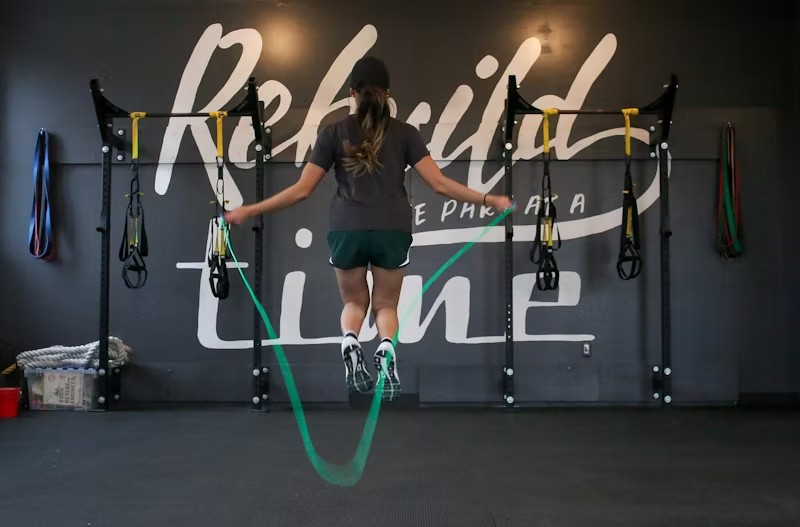
Skipping rope, also known as jump rope, is a versatile cardiovascular exercise that offers numerous health benefits. It’s an effective way to improve cardiovascular fitness, coordination, balance, and endurance. Additionally, it aids in burning calories, making it a popular choice for weight loss and overall fitness.
Benefits of Skipping Rope:
Cardiovascular Health: Regular skipping sessions can enhance heart health by improving circulation and increasing heart rate.
Weight Loss: It’s a high-intensity exercise that can burn a significant number of calories in a short period, aiding in weight management.
Improved Coordination: The rhythmic nature of skipping helps enhance hand-eye coordination and timing.
Bone Density: Weight-bearing exercises like skipping can contribute to increased bone density, reducing the risk of osteoporosis.
Getting Started with Skipping Rope:
For beginners, it’s important to start slowly and gradually increase intensity to allow your body to adapt. Here’s a simple beginner-friendly routine:
Warm-Up (5 minutes):
Jog in place
Jumping jacks
Arm circles
Squats
Workout Routine:
Basic Jump: Swing the rope over your head and jump as it passes under your feet. Land softly on the balls of both feet. Perform for 30 seconds, followed by a 30-second rest. Repeat this cycle for a total of 5 minutes.
Cool-Down (5 minutes):
Marching on the spot
Hamstring stretches
Calf stretches
Child’s pose
Tips for Effective Skipping:
Proper Form: Keep your elbows close to your sides and rotate the rope with your wrists, not your arms. Maintain an upright posture and engage your core.
Footwear: Wear supportive athletic shoes to cushion your jumps and reduce impact on your joints.
Surface: Choose a flat, hard surface for skipping. Avoid soft surfaces like grass, as they can slow down the rope and disrupt your rhythm.
Progression: As you become more comfortable, introduce variations like alternate-foot jumps, high knees, or double unders to challenge yourself and keep the workouts engaging.
Remember, consistency is key. Aim to incorporate skipping sessions into your routine several times a week for optimal health benefits. Always listen to your body and consult with a fitness professional if you have any concerns or pre-existing health conditions.
Who all should avoid skipping rope exercise
Skipping rope is a beneficial cardiovascular exercise that enhances fitness, coordination, and endurance. However, it’s not suitable for everyone. Individuals with certain health conditions should approach this activity with caution or avoid it altogether. Before starting any new exercise regimen, it’s essential to consult with a healthcare professional, especially if you have:
Cardiovascular Issues: Those with heart diseases, such as ischemic heart disease or congestive heart failure, should be cautious. Jumping rope is a high-intensity exercise that can significantly challenge the heart.
Respiratory Conditions: Individuals with asthma may find that skipping rope exacerbates their symptoms due to its intensity.
Joint Problems: People with arthritis, especially in the knees, or those recovering from bone injuries should be careful. The repetitive impact can strain joints.
Osteoporosis: Those with osteoporosis should avoid high-impact activities like skipping rope, as they can increase the risk of fractures.
Recent Surgeries or Illnesses: If you’ve recently undergone major surgery or are recuperating from an illness, it’s advisable to avoid high-intensity exercises like jumping rope until you’ve fully recovered.
For individuals without these conditions, skipping rope can be a safe and effective exercise when performed with proper technique and appropriate footwear. It’s crucial to start gradually, warm up adequately, and listen to your body’s signals to prevent injuries.
Can we do skipping rope exercise daily
Yes, skipping rope (jump rope) exercises can be done daily, provided you listen to your body and don’t overdo it. It is an excellent cardiovascular exercise that helps improve endurance, coordination, and leg strength. However, if you’re new to it, start slow and gradually increase your duration or intensity to avoid overuse injuries.
Here are some tips for skipping rope daily:
Start slow: Begin with short sessions (5-10 minutes) and gradually increase the time as your fitness improves.
Warm up and cool down: Always warm up before and cool down after your session to prevent injuries.
Rest when needed: If you experience pain or discomfort, take rest days to allow your body to recover.
Focus on form: Ensure proper posture and use your wrists to control the rope, rather than your arms, to avoid unnecessary strain.
Cross-train: Consider mixing in other forms of exercise, like strength training, to balance your routine and avoid repetitive stress injuries.
If done correctly, skipping rope daily can be a great part of your fitness regimen. Just remember to listen to your body and rest if you feel fatigued.
